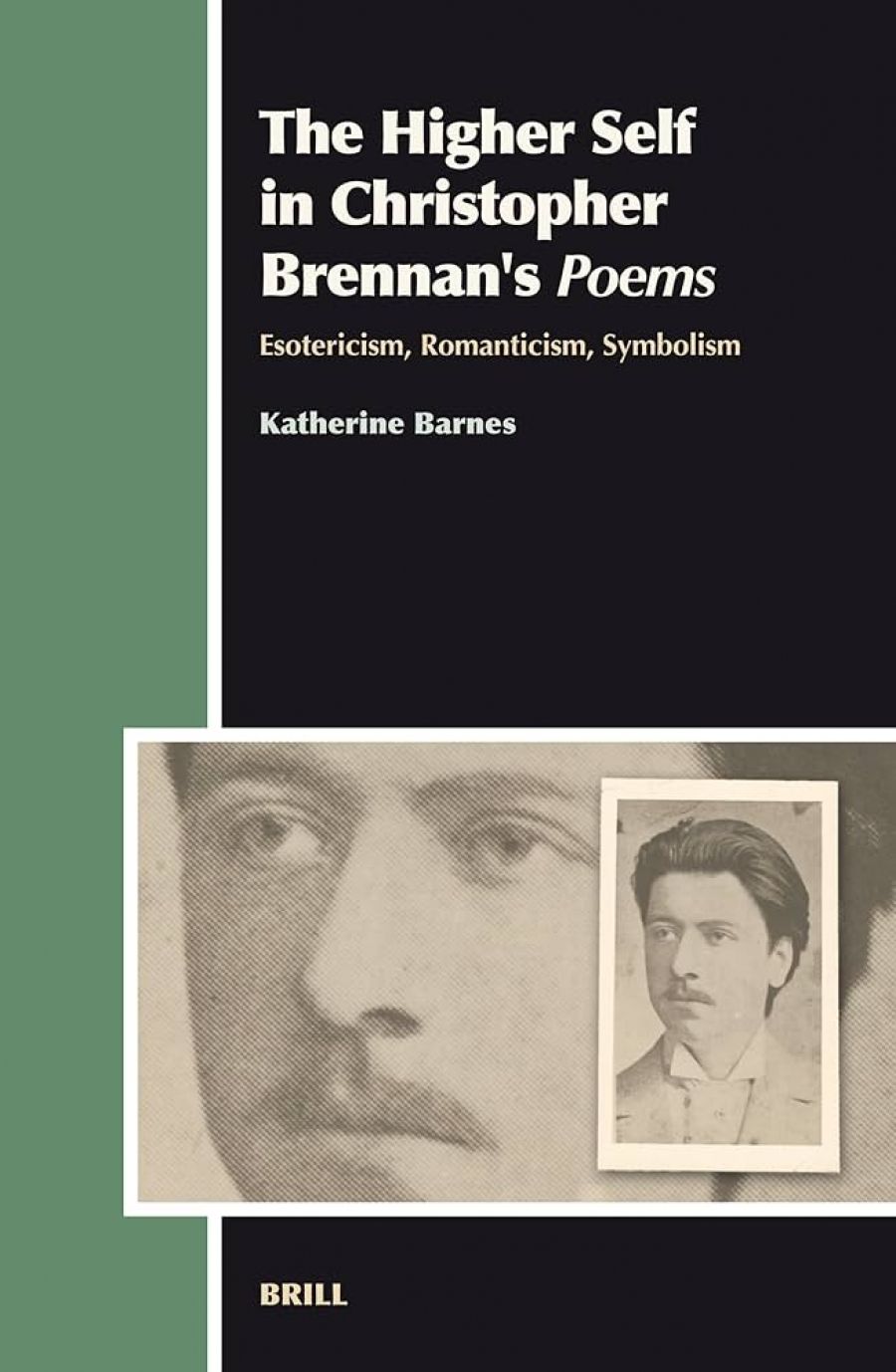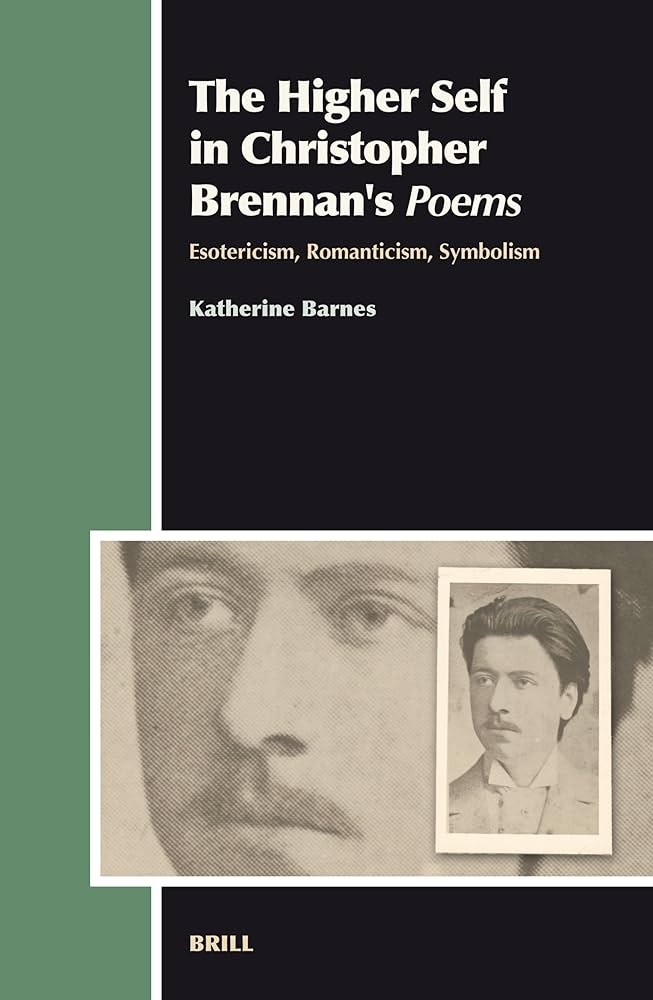
- Free Article: No
- Contents Category: Literary Studies
- Custom Article Title: Esoteric quest
- Review Article: Yes
- Article Title: Esoteric quest
- Online Only: No
- Custom Highlight Text:
Katherine Barnes’s book on Christopher Brennan (1870 – 1932) is unusual in the Australian academy in that the work does not much concern itself with postmodern theory, or the kinds of questions that might arise from Brennan’s oeuvre for a modern reader. It bypasses the more familiar kind of enquiry, such as the intriguing questions that Brennan might be seen to raise in relationship to psychoanalysis, and whether or not he might conceivably have been a first-wave feminist. It is something quite different: an enlivening scholarly engagement with Brennan’s sources, especially those available to him in Australia, in particular his esoteric sources.
- Book 1 Title: The Higher Self in Christopher Brennan's Poems
- Book 1 Subtitle: Esotericism, Romanticism, Symbolism
- Book 1 Biblio: Brill, US$194 hb, 317 pp
- Book 1 Cover Small (400 x 600):

- Book 1 Cover (800 x 1200):

Barnes’s book is welcome after a protracted green (‘some, but not enough’) drought of critical publishing on Brennan in the past two decades. It seems a long time since the heady days of the 1970s and 1980s and the Christopher Brennan Society in Sydney (comprising such as Edmund Campion, Gerard Windsor, Axel Clark, Annette Stewart and Robyn Marsden), and the loving work by such as Alec Chisholm, G.A. Wilkes, Judith Wright, A.D. Hope, Dorothy Green and Noel Macainsh, which constructed Brennan as canonical, and Australia’s most impressive palaeo-modernist, with strong connections to European poetry and to Yeats. These days, it is difficult (I know, because I tried a few recently) to interest our students in the archaic language and learning of ‘The Forest of Night’ sequence (I would have done much better with the ‘Wanderer,’ but it sacrifices complexity, makes little sense without ‘The Forest of Night’, and lacks the electricity of the middle sequence of Poems, but the bottom line was that I was unwilling for them to have studied Australian Literature without meeting Lilith). The stumbling block is clearly the lack of a good annotated edition which can bring the very different intellectual frameworks into focus for new generations of readers. Barnes may be the person to annotate Brennan, though this probably requires a team of scholars because of the breadth and depth of his scholarship.
Barnes is well aware of the difficulties of reading Brennan, and cites both Wright’s and Hope’s appreciative critical response to Brennan’s poetry and their despair that most readers will lack the requisite ‘background in philosophic-poetic argument of the west’ to read him. Using Lilith to anchor her analysis, Barnes does an excellent job of unfolding aspects of the myriad of international philosophical debates with which Brennan was engaged, and does so in an accessible language, in the process succeeding in her aim to make him ‘different from what we had taken him to be, and better … than we had ever imagined’. She represents Brennan as engaging with Neoplatonism (and especially its esoteric and mystical traditions, as refracted by Boehme), late Romanticism (a Blake-suffused Yeats comes into view) and Symbolism (in particular, writing back to very specific key moments in Mallarmé), as well as the gamut of new disciplines appearing in the last quarter of the nineteenth century. Barnes argues that Brennan’s project challenged secularism and was centred on relocating the divine in the human imagination; Poems argues for art as the site for the reunification of the human mind and nature.
The notion of a ‘fallen’ Lilith being fallen precisely because of her identification with nature and as being potentially reclaimable for the divine is one that chimes very closely with contemporary feminist scholars’ attempts to reclaim Lilith from her debasement in Jewish tradition. Brennan’s mobilisation of a very traditional repertoire of symbols for the earth, nature and the seasons, and his refusal of the specificities of Australian landscape, make a lot more sense in the light of this ongoing international debate which was intent on defining the nature the human soul and a soul firmly located in the phenomenal – the natural cycles and the earth itself. What emerges is a Brennan profoundly influenced by his Jesuitical Catholicism (the traces of which Barnes perhaps underestimates) and at the same time wrestling intellectually with the sacred as an agnostic and a post-religionist. It was a surprise to discover that his struggle began in Australia with his Sydney Master of Arts thesis, ‘The Metaphysic of Nescience’ (a synonym for agnosticism) in 1891. Free thought and the engagement with secularisation were, long before John Anderson, alive and well in the 1890s at Sydney University and for Bren-nan, before his life-altering encounter with Europe and Mallarmé in 1893.
What Barnes also implicitly does is to offer more evidence for the thesis that Chris Wallace-Crabbe outlined in ‘The Legend of the Legend of the Nineties’ (1982): that demotic bush nationalism rubbed shoulders even in the pages of the Bulletin (especially under A.G. Stephens’s editorship) with high-art engagements with literary Europe and its poetry. English, Irish, French and American poetry were reviewed alongside new Australian fiction and the poetry of Brennan and John Shaw Neilson. Brennan himself wrote Poems while working (‘under a sky of uncreated mud’) in the basement of the Public Library of New South Wales at the same time as he alternated between his accessioning duties and consuming brand new editions of European works, as well as studies of philosophy, psychology and theories of the unconscious (especially Hartmann), comparative mythology and anthropology, psychic research, Gnosticism and mysticism.
Brennan’s interests were broad. The Public Library of New South Wales, in which he worked for thirteen years, was, like the fledgling State Library of Victoria (SLV), where Redmond Barry himself unpacked and shelved the best and newest from Europe in the 1890s, a magnificently well-funded institution which attracted the kind of state sponsorship that gold made possible (and that football now attracts). Even when exiled to Goulburn, Brennan had access to a School of Arts Library stocked half a century earlier by the prodigiously learned Daniel Deniehy, and used subsequently by Edward Maitland, the thinker and utopian novelist. One thinks too of the riches available in the same decade to Furphy, equally dependent on libraries and also engaged in a post-religious quest and the ferment of new ideas, in both the Shepparton Mechanics’ Institute and the SLV.
Other features of the text to celebrate are its critical deployment of the ‘expressive topography’ of the original edition of the text, and its use of Brennan’s Prose, the lucid and undervalued lectures that he wrote as professor of modern languages at Sydney.
This is a book that Brennan enthusiasts will have to have (despite its hefty price tag) and one that is indispensable for library collections of Australian literature around the world.


Comments powered by CComment